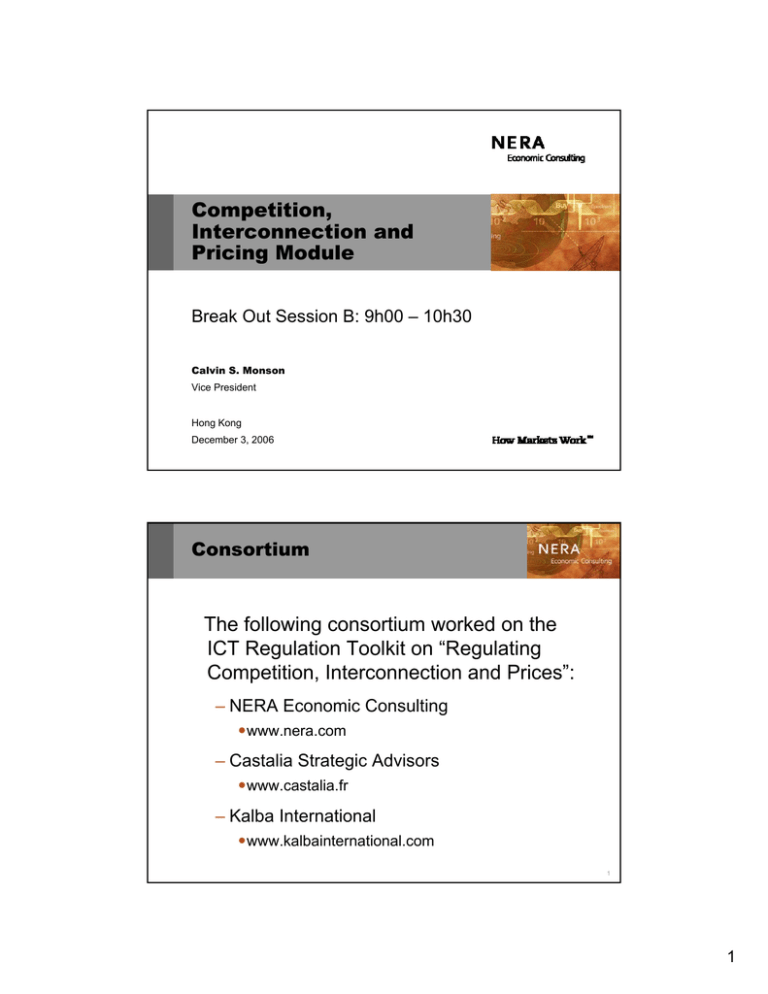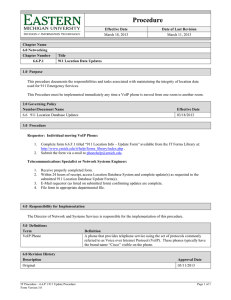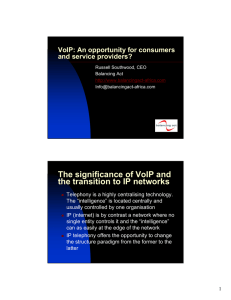
Competition,
Interconnection and
Pricing Module
Break Out Session B: 9h00 – 10h30
Calvin S. Monson
Vice President
Hong Kong
December 3, 2006
Consortium
The following consortium worked on the
ICT Regulation Toolkit on “Regulating
Competition, Interconnection and Prices”:
– NERA Economic Consulting
ywww.nera.com
– Castalia Strategic Advisors
ywww.castalia.fr
– Kalba International
ywww.kalbainternational.com
1
1
Program for Break Out Session
Presentation: Migrating today’s tariff regulation to the
NGN and VoIP environment
– Identifying changes to laws or regulations that may be required
– How can the Toolkit help?
Simulation exercise: Roaming
– How to respond when industry argues that roaming regulation is
not necessary
Identification of best practices
2
Migrating today’s tariff regulation to
the NGN and VoIP environment
Identifying changes to laws or regulations that may be
required
How can the Toolkit help?
– Principles
– Examples
Let’s look at the Toolkit.
– http://www.ictregulationtoolkit.org/
3
2
Migrating tariff regulation
The Toolkit offers an entire chapter of Module 2 on the
topic of “New Paradigms: Voice over IP and IXPs”
– ICT Regulation Toolkit: Competition and Price Regulation: 4
VOICE OVER IP AND IXPs
4
Chapter 4 VoIP
Background to the Internet and its development,
An overview of Voice over the Internet Protocol (VoIP),
Opportunities for arbitrage, that are creating pressures for
change to existing regulatory and commercial models,
The implications of VoIP for regulators, and for
interconnection,
VoIP over wireless technologies,
International benchmarking of charges for network
access, and
Internet Exchange Points (IXPs).
5
3
Related practice notes
Nigeria: Proposed Regulatory Treatment of Voice over Internet
Protocol
European Union: “Light Touch” Regulation of Voice over Internet
Protocol
Network Neutrality
Kenya: A Middle Path to VoIP Adoption
Japan: Market-Fostering Framework for VoIP
Hong Kong: Regulation of Voice over the Internet Protocol
Barbados: Policy on Voice over Internet Protocol
Austria: Regulation of VoIP Services
6
Related Reference Documents
OFTA Services-Based Operator Licence (359 KB PDF)
Barbados: Voice over Internet Protocol Draft Policy (209
KB PDF)
7
4
VoIP and Regulation
Key implications of VoIP for regulators
– Remove asymmetric regulation on incumbents?, or
– Protect incumbents from competition?
Trends in the regulation of VoIP services
– Telephone numbering assignments
– Telephone number portability
– Access to emergency services
The effect of differential regulation of VoIP and
conventional telephony
– Focus new investment into unregulated broadband networks
– Migrate services onto those new networks
8
Changing laws and regulations
Authorization to be flexible in regulation is needed. The
regulator needs to be able to forbear from regulation as
market forces take over.
To apply flexibility, the regulator needs to understand how
to analyze the competitiveness of a market
– Define the relevant market or markets,
– Assess the level of competition in the market, without the
behavior or act in question, and
– Assess the level of competition in the market, with the behavior
or act in question.
9
5
Changing laws and regulations
There will likely be a continuing role for the regulator in
resolving interconnection problems.
Most PSTN operators are still defining the price of
interconnection in per call or per minute terms, but this is
likely to give way to capacity-based interconnection
arrangements that are typical in the Internet.
Price regulation will need to adapt to permit greater
flexibility as new services and technologies grow in size
and influence. Tariff rebalancing helps minimize the
impact of NGNs on vulnerable incumbents.
10
Simulation exercise: Roaming
How to respond when industry argues that roaming
regulation is not necessary.
– Prices are falling
– Subscribership is increasing
– In general, the argument would be that competition is solving the
problem and regulatory intervention is not warranted
Section 3.4 of the Module deals with Mobile
Interconnection.
Subsection 3.4.5 deals with Mobile Roaming.
11
6
Simulation exercise: Roaming
Exercise #1: National Roaming
– Group A: NRA resolving dispute between established mobile
operator and new entrant.
– Group B: Established mobile operator that has nation-wide
coverage.
– Group C: New entrant that only has coverage in the capital city
and is requesting that NRA require the established operator to
offer roaming at national level to entrant.
We will divide into groups for this role-playing exercise.
12
Simulation exercise: Roaming
Exercise #2: International Roaming
– Group A: NRA in Country A.
– Group B: NRA in Country B.
– Roaming rates between the two countries are 5X higher than
basic costs and 4X higher than retail domestic calling.
– Group C: Industry.
We will divide into groups for this role-playing exercise.
13
7
Contact Us
Calvin S. Monson
Vice President
Chicago
+1 312 573 2801
Calvin.Monson@nera.com
© Copyright 2006
National Economic Research Associates, Inc.
All rights reserved.
8






